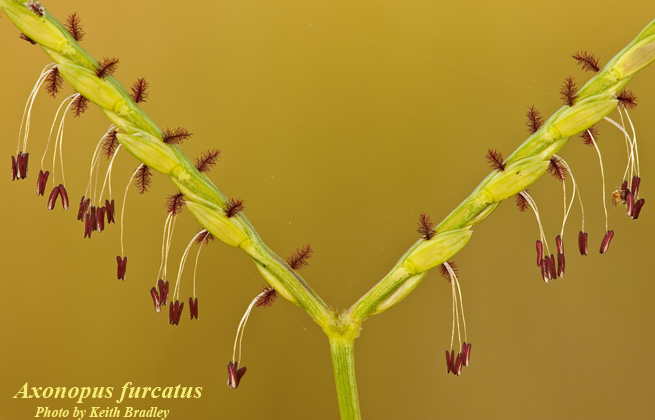Difference between revisions of "Axonopus furcatus"
Lsandstrum (talk | contribs) (→Habitat) |
Juliec4335 (talk | contribs) (→Habitat) |
||
| Line 33: | Line 33: | ||
<!--Natural communities, human disturbed habitats, topography, hydrology, soils, light, fire regime requirements for removal of competition, etc.--> | <!--Natural communities, human disturbed habitats, topography, hydrology, soils, light, fire regime requirements for removal of competition, etc.--> | ||
''A. furcatus'' can be found in maritime forests, sandy forest, bottomlands, calcareous wet meadows and other coastal regions. <ref name= "Weakley"> Weakley, A. S. (2015). Flora of the Southern and Mid-Atlantic States. Chapel Hill, NC, University of North Carolina Herbarium.</ref> It has been found in plant communities including pine, palmetto, and wet prairie. <ref name= "Hilmon"> Hilmon, J. B. (1964). "Plants of the Caloosa Experimental Range " U.S. Forest Service Research Paper SE-12 </ref> Recorded habitats include longleaf pine sandhills with wet depressions, cypress swamps, rich pasture, standing water, deciduous wooded bottoms on sandy levee, ponds, banks of rivers, and wooded floodplains. <ref name = "FSU herbarium"> URL: http://herbarium.bio.fsu.edu. Last accessed: June 2018. Collectors: Loran C. Anderson, Cecil R Slaughter, Jason R. Swallen, Robert Kral, Sidney McDaniel, Robert K. Godfrey, G. W. Reinert States and counties: Florida (Alachua, Osceola, Collier, Madison, Jackson, Leon, Nassau, Franklin) </ref> ''A. furcatus'' responds positively or not at all to soil disturbance by roller chopping in South Florida.<ref>Lewis, C.E. (1970). Responses to Chopping and Rock Phosphate on South Florida Ranges. Journal of Range Management 23(4):276-282.</ref> | ''A. furcatus'' can be found in maritime forests, sandy forest, bottomlands, calcareous wet meadows and other coastal regions. <ref name= "Weakley"> Weakley, A. S. (2015). Flora of the Southern and Mid-Atlantic States. Chapel Hill, NC, University of North Carolina Herbarium.</ref> It has been found in plant communities including pine, palmetto, and wet prairie. <ref name= "Hilmon"> Hilmon, J. B. (1964). "Plants of the Caloosa Experimental Range " U.S. Forest Service Research Paper SE-12 </ref> Recorded habitats include longleaf pine sandhills with wet depressions, cypress swamps, rich pasture, standing water, deciduous wooded bottoms on sandy levee, ponds, banks of rivers, and wooded floodplains. <ref name = "FSU herbarium"> URL: http://herbarium.bio.fsu.edu. Last accessed: June 2018. Collectors: Loran C. Anderson, Cecil R Slaughter, Jason R. Swallen, Robert Kral, Sidney McDaniel, Robert K. Godfrey, G. W. Reinert States and counties: Florida (Alachua, Osceola, Collier, Madison, Jackson, Leon, Nassau, Franklin) </ref> ''A. furcatus'' responds positively or not at all to soil disturbance by roller chopping in South Florida.<ref>Lewis, C.E. (1970). Responses to Chopping and Rock Phosphate on South Florida Ranges. Journal of Range Management 23(4):276-282.</ref> | ||
| + | |||
| + | ''Axonopus furcatus'' is frequent and abundant in the Calcareous Savannas community type as described in Carr et al. (2010).<ref>Carr, S.C., K.M. Robertson, and R.K. Peet. 2010. A vegetation classification of fire-dependent pinelands of Florida. Castanea 75:153-189.</ref> | ||
===Phenology=== <!--Timing off flowering, fruiting, seed dispersal, and environmental triggers. Cite PanFlora website if appropriate: http://www.gilnelson.com/PanFlora/ --> | ===Phenology=== <!--Timing off flowering, fruiting, seed dispersal, and environmental triggers. Cite PanFlora website if appropriate: http://www.gilnelson.com/PanFlora/ --> | ||
Revision as of 17:52, 24 July 2020
Common names: Big Carpetgrass
| Axonopus furcatus | |
|---|---|

| |
| Photo by the Atlas of Florida Plants Database | |
| Scientific classification | |
| Kingdom: | Plantae |
| Division: | Magnoliophyta - Flowering plants |
| Class: | Liliopsida - Moncots |
| Order: | Cyperales |
| Family: | Poaceae |
| Genus: | Axonopus |
| Species: | A. furcatus |
| Binomial name | |
| Axonopus furcatus (Fluegge) Hitchcock | |
Contents
Taxonomic Notes
Synonym: Paspalum furcatum (Flügge)
Varieties: none
Description
A. furcatus is a perennial graminoid of the Poaceae family native to North America. [1]
Distribution
The A. furcatus is found along the Coastal Plains of Virginia to Florida and west to Texas and Arkansas. [1]
Ecology
Habitat
A. furcatus can be found in maritime forests, sandy forest, bottomlands, calcareous wet meadows and other coastal regions. [2] It has been found in plant communities including pine, palmetto, and wet prairie. [3] Recorded habitats include longleaf pine sandhills with wet depressions, cypress swamps, rich pasture, standing water, deciduous wooded bottoms on sandy levee, ponds, banks of rivers, and wooded floodplains. [4] A. furcatus responds positively or not at all to soil disturbance by roller chopping in South Florida.[5]
Axonopus furcatus is frequent and abundant in the Calcareous Savannas community type as described in Carr et al. (2010).[6]
Phenology
This species has been observed to flower in June.[7]
Fire ecology
A study found A. furcatus to be more abundant in sites that were winter burned and grazed.[8]
Use by animals
It is considered to be of fair forage value.[3]
Conservation and Management
It is listed as endangered and extirpated by the Maryland Department of Natural Resources.[1]
Cultivation and restoration
Photo Gallery
References and notes
- ↑ 1.0 1.1 1.2 USDA Plant Database
- ↑ Weakley, A. S. (2015). Flora of the Southern and Mid-Atlantic States. Chapel Hill, NC, University of North Carolina Herbarium.
- ↑ 3.0 3.1 Hilmon, J. B. (1964). "Plants of the Caloosa Experimental Range " U.S. Forest Service Research Paper SE-12
- ↑ URL: http://herbarium.bio.fsu.edu. Last accessed: June 2018. Collectors: Loran C. Anderson, Cecil R Slaughter, Jason R. Swallen, Robert Kral, Sidney McDaniel, Robert K. Godfrey, G. W. Reinert States and counties: Florida (Alachua, Osceola, Collier, Madison, Jackson, Leon, Nassau, Franklin)
- ↑ Lewis, C.E. (1970). Responses to Chopping and Rock Phosphate on South Florida Ranges. Journal of Range Management 23(4):276-282.
- ↑ Carr, S.C., K.M. Robertson, and R.K. Peet. 2010. A vegetation classification of fire-dependent pinelands of Florida. Castanea 75:153-189.
- ↑ Nelson, G. PanFlora: Plant data for the eastern United States with emphasis on the Southeastern Coastal Plains, Florida, and the Florida Panhandle. www.gilnelson.com/PanFlora/ Accessed: 26 MAR 2019
- ↑ Boughton, E., et al. (2013). "Season of fire and nutrient enrichment affect plant community dynamics in subtropical semi-natural grasslands released from agriculture." Biological Conservation 158: 239-247.